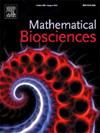脂肪细胞大小分布:组织特性的数学模型
IF 1.8
4区 数学
Q2 BIOLOGY
引用次数: 0
摘要
白脂肪组织负责将多余的能量以脂类的形式储存起来。参与这一过程的主要细胞--脂肪细胞--会调整自己的大小,直径可达 200 微米,以适应储存的需要。此外,它们的大小分布是双峰的。之前一个基于脂质通量的数学模型提供了大小分布的双峰性。然而,该模型并未充分探讨细胞群内部的可变性。在以前的模型中,双峰性被认为是平衡状态下细胞大小双稳态分布的结果:这意味着脂肪细胞必须有两种稳定的大小。在这项研究中,我们首先提供了一种计算方法来评估平衡状态,并将细胞的可变性考虑在内。我们的结果表明,这种可变性是提供真实分布的关键。此外,我们还发现,具有双稳态细胞比例的大小分布与测量结果并不一致。我们发现,脂肪组织内的单稳态(即一种平衡尺寸)轮廓足以解释双峰性,并能定性地再现尺寸分布数据。因此,我们证明了脂肪组织大小分布的双峰性并不是由细胞的双稳态性直接引起的,而是由组织特性引起的。本文章由计算机程序翻译,如有差异,请以英文原文为准。
Adipocyte size distribution: Mathematical model of a tissue property
White adipose tissue is in charge of storing excess of energy in form of lipids. The main cells involved in the process – the adipocytes – adapt their sizes up to of diameter to accommodate the storage. In addition, their size distribution is bimodal. A previous mathematical model based on lipid fluxes provided size distribution bimodality. However, the variability within cell population was not fully explored. In the previous model, bimodality was considered a consequence of a bistable distribution of cell sizes at equilibrium: meaning that adipocytes had to have two stable sizes. In this study, we first provide a computational method to evaluate equilibria taking into account cells variability. Our results suggest that this variability is key to provide realistic distributions. In addition, we show that size distributions with a proportion of cell with bi-stable profile are not in good agreement with the measurements. We find that mono-stable (i.e. one equilibrium size) profile within the adipose tissue is enough to explain bimodality and to reproduce qualitatively size distribution data. We thus show that bimodality of adipose tissue size distribution does not arise directly from cellular bi-stability but rather from a tissue property.
求助全文
通过发布文献求助,成功后即可免费获取论文全文。
去求助
来源期刊

Mathematical Biosciences
生物-生物学
CiteScore
7.50
自引率
2.30%
发文量
67
审稿时长
18 days
期刊介绍:
Mathematical Biosciences publishes work providing new concepts or new understanding of biological systems using mathematical models, or methodological articles likely to find application to multiple biological systems. Papers are expected to present a major research finding of broad significance for the biological sciences, or mathematical biology. Mathematical Biosciences welcomes original research articles, letters, reviews and perspectives.
 求助内容:
求助内容: 应助结果提醒方式:
应助结果提醒方式:


